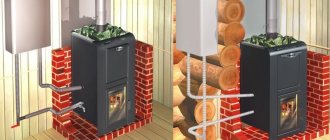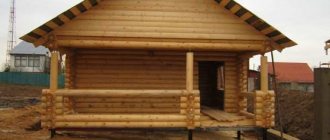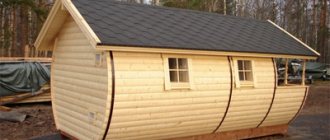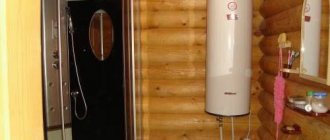Why doesn’t the water boil in the sauna and bathhouse? A visit to the sauna or bathhouse is an excellent opportunity to combine the pleasure of water treatments with significant health benefits. And such a pastime can make you think about some things. So, for example, why doesn’t water boil when it’s in a hot heated room? After all, the thermometer in the steam room can reach +100, 120 degrees, especially if you take measurements directly under the ceiling.
Why doesn’t the water in the sauna boil at such temperatures? Everyone knows from school courses that it should boil at 100 degrees.
How to build a stove with a tank with your own hands?
As noted above, such a stove can be purchased ready-made, but many bathhouse fans make such a device with their own hands.
This, by the way, is not difficult, especially since everything necessary for production is sold in the same stores. Now we will tell you exactly how such stoves with tanks are made. Stage one
. You should start by preparing all the required details. The main part is a pipe, the thickness of which is 50 cm and the length is 150 cm. The pipe should be cut into two parts - 90 cm long (for the combustion chamber) and 60 cm (for the tank).
Stage two
. Next, a stove is made from the pipe. To do this, a rectangular hole 5x20 cm is made in its lower part, which will serve as a blower, then a steel plate 1.2 cm thick is welded above it. A grate is placed in the blower and carefully fixed.
Stage three
. The remains of the pipe will be a niche for the door and combustion chamber, so the latch is attached here. A piece of pipe about 35 cm long is welded above the combustion chamber - it will serve as a heater. It should be taken into account that the distance between the top and bottom must be at least 10 cm. At the end, the back part is welded and a door is constructed.
Stage four
. Kamenka on? it is filled with pebbles, after which a steel rod is welded - it will prevent the contents from spilling out. A coupling made of a steel tire is attached to the top of the structure. This tire will simultaneously serve as a base for a water container.
Stage five
. A steel circle 0.8 cm thick is welded to the end of the container, and a hole is made in it for the chimney. The bottom of the pipe must be welded to the bottom to prevent moisture from penetrating into the combustion chamber.
Stage six
. The upper part of the tank must be closed with a semicircle made of steel, and a chimney must be welded to the hole. There should be a hole at the top through which water can be poured. Additionally, a lid with a handle is available.
That's it, the homemade oven is almost ready! More detailed information is in the video below.
Fourth principle
- heating of the human body and the room by infrared radiation, for example, radiation from electric coils, coals, hot stones or oven walls, as well as solar radiation. In this case, the air may not heat up at all and be very cold (down to sub-zero temperatures) and very dry. However, a person will feel very hot in the cold air and will sweat. On the way to creating such “steam rooms” there are significant technical difficulties in implementing circular heating of the body. Although the first samples of infrared cabins (albeit still far from perfect and suitable only for medical procedures) have already appeared on the US market, however, anyone who has a metal “potbelly stove” can feel the effect of infrared radiation: sometimes it is simply impossible to stand next to it - burns. The principle is valuable because the radiation here goes directly to the surface of the walls and to the human body. Thus, the essence of the principle is that walls and people are heated by infrared radiation, and the air is then heated by the walls.
Embedded system
The simplest and most common way to install a tank for heating water is to install it on one of the sides or on top of the sauna stove. The ideal option is that a water tank is installed inside the stove and goes out simultaneously into two rooms (steam room and sink). The capacity of such a tank can be any, and the heating method is wood-fired.
It’s another matter if the sauna heating stove has already been built and it does not have a tank. In this case, a mounted option is used (usually on the side or front in the steam room). The tank capacity is about 40-70 liters, and this volume is heated (using wood) in 1.2-1.6 hours. Heating can be accelerated by providing thermal insulation of the tank walls. The main drawback is that the tank always steams when heated, which means it is not suitable as a sauna heater. But for a Russian bath it is a simple and effective way to heat water.
Main reasons
Heating of water in baths can be carried out using a tank on a pipe, a remote container or using a heat exchanger. Each method has both obvious advantages and disadvantages.
The most convenient to use is a remote tank, and the easiest to install are considered to be mounted or mounted structures.
At the same time, pipe-mounted tanks are very economical, but these are the models that heat the water unevenly.
Poor heating can be associated not only with the design of the tank and the method of its installation, but also with the characteristics of the material from which it is made. For example, stainless steel containers have sufficient thermal conductivity, while cast iron tanks take a long time to heat up, but are able to retain heat even after the stove has stopped firing.
Fifth principle
(and, apparently, optimal for stationary baths) - heating the air and walls due to the hot water located in the reservoir (swimming pool, bath). That is, they heat the water in the reservoir, and everything else heats up by itself. This principle is cultivated by the Japanese as a bathing principle. The Japanese procedure (“furo” or “sento”) consists of two stages. First, they “sweat” in hot water, and gradually increase the temperature as they “get used to it.” At the same time, people actually sweat in hot water. Moreover, they sweat a lot in optimal conditions, when the legs and arms are at the same temperatures, and the head does not overheat. The sweat does not evaporate, but is immediately washed off. Frankly speaking, the conditions are ideal. You can wash and scrub at the same time.
Then, at the second stage, the person does not cool himself intensely, as sometimes happens in a Russian or Finnish bathhouse, but, on the contrary, wraps himself up and lies under a blanket on the couch and sweats “pure sweat” for a long time. Every steamer knows how long after a steam room the body remains hot inside. Sweating “clean sweat” is actually beneficial, but it is quite difficult to withstand 1-2 hours.
The method at first glance is extremely common and simple. Essentially, it’s just a bathtub—every city apartment has one. Or a hot pool, of which there are many, if not in our country, then in Europe and America for sure. But it could have originated in places where there were hot natural water sources (geothermal waters). And it can only develop at a high level of civilization, since it requires huge amounts of heat to heat, supply and store large amounts of hot water. It is difficult, for example, to seriously imagine it being viable not only in the cold wild nature of Ancient Rus', but even in the conditions of a modern dacha plot. And even more so in winter.
How to choose a tank for a bath?
Finding the best option involves many factors. And if everything is clear with the material of manufacture (stainless steel looks much more preferable than steel or other possible materials), then with other points you often have to rack your brains.
Selecting the volume
As mentioned above, the necessary and sufficient displacement is determined based on the norm of 8-10 liters for each lover of steam. It turns out that it is enough to count the maximum number of people and multiply by 8-10. However, this is only half the truth, as there are other criteria. For example, the area of the room and the performance of the stove. If the stove is small and has relatively low power, and the room is far from small, you will have to give up the idea of installing a large container (provided the tank is mounted on the stove body). The reason is that in such a situation, the power of the furnace will hardly be enough even to heat the air in the steam room, not to mention the water. Conversely, if a large amount of heat is generated and the container is small, then the water will quickly boil away. The main thing when choosing a displacement is to analyze all the information and settle on the option that satisfies each condition.
Selecting the tank type
Here everything is much more complicated, since there are a lot of options: a stove with a built-in tank, containers on a pipe, and remote tanks. Moreover, the latter can be mounted anywhere, including the furnace body, washing compartment or under a shelf. Let's talk briefly about the advantages and disadvantages of each method.
- A built-in tank is an excellent solution for organizing hot water supply in a bathhouse (mainly due to direct heating with a flame, which gives high efficiency). However, there are still some shortcomings. Firstly, a large share of the heat is spent on heating the water, while the air in the steam room also needs to be heated. Secondly, there are restrictions on the size and, accordingly, the volume of the tank. And the size of the stove increases, reducing the usable area of the steam room. It turns out that if there is not enough space in this section of the bathhouse, then it is better to think about a tank with a pipe or an external model.
- In addition to the fact that the tank on the pipe allows you to save space, it also does not reduce the amount of heat that is transferred directly to the steam room (the water is heated by high-temperature gases that are removed through the chimney). In addition, hot smoke transfers heat energy much faster than any heat exchanger. But not everything is so rosy. Among the disadvantages of pipe-mounted tanks for a bathhouse, we include potential difficulties in “delivering” boiling water to the washing compartment and the possibility of the formation of cold air pockets, which leads to the deposition of destructive substances and clogging of the chimney walls. A fair amount of heat is transferred to the liquid, and the temperature of the exhaust smoke decreases, which is the reason for the appearance of the above-mentioned traffic jams.
- Remote containers are very convenient to use, as they can be placed anywhere you want. Most often, such tanks are located in the washing compartment, which is very unsafe, but convenient in the sense that the water is initially located where it needs to be used. In order to reduce the likelihood of getting a burn to zero, it is better to install a container under the shelf. It should also be remembered that installing the tank on the stove body (as well as installing the tank on a pipe) will lead to a reduction in the proportion of heat spent on maintaining a high temperature in the room.
The main conclusion from all of the above is that when choosing a water tank for a bathhouse, you need to rely on a whole set of conditions. Consulting professionals will not be superfluous at all, because only specialists will be able to say for sure which tank satisfies not only all your requirements, but also technical conditions.
Fortunately, today the supply of hot water tanks on the market not only covers demand, but even exceeds it. That is why there is no shadow of a doubt that finding a strong, durable and suitable tank is not at all difficult.
The presence of hot water in the bathhouse is a prerequisite for its normal functioning. Heating can be carried out using a gas water heater, electricity, flue gases from the combustion of wood, or by connecting to a centralized network. All options have their pros and cons, based on which a solution is selected for each specific case.
What is the problem?
The problem of low water heating rate arises mainly among owners of heat exchanger registers connected to external tanks. Samovar-type containers most often do not cause problems, and it manages to reach a comfortable temperature just in time. There are several reasons for the low heating rate. And they can act both individually and in combination.
Installation errors
The heat exchanger heats the water in the remote tank due to natural circulation
Pay attention to the design of the register: the lower pipe on its side surface is the inlet for cold water, and the upper pipe is the outlet for hot water. One of the most common installation mistakes is connecting the remote tank to the heat exchangers with flexible leads of the same length
In this case, the hot water outlet hose will sag and circulation conditions will be disrupted.
The absence of slopes when connecting with a pipe will lead to the same outcome. Another reason for poor circulation is that the diameter of the inlets is too small. The water flow will not be able to overcome the high hydraulic resistance.
Inconsistency in heat exchanger power and excess storage tank volume
If the power of the furnace is selected “close” to the volume of the bath, and the heat exchanger takes away some of the heat, then most likely the low rate of heating the water will be accompanied by an incorrect temperature regime in the steam room. By cooling the starting section, the register reduces the heat input into the steam room by 10%. This reserve should be included when choosing a stove.
The ratio of the volumes of the storage tank and the heat exchanger register should be 6...10. In this case, the water has time to warm up in 2 – 2.5 hours.
What to do
In wall-mounted tanks, water often heats up too quickly and boils, so it is not practical to install such structures on compact steel stoves.
Containers that are too large do not always have time to warm up the water, so they must be replaced with more practical and compact “samovar” type devices.
The water heating tank should be selected depending on the characteristics of the furnace design. Otherwise, insufficient heating or excessive overheating, as well as premature boiling of water, may occur.
Water heaters
Modern water heaters can be divided into three groups depending on the type of fuel:
- wood;
- gas;
- electric.
Electrical
There are two types of electric water heaters:
- Flow-through devices are compact devices that quickly heat the liquid flowing through them. Can quickly dispense hot liquid. In winter, water is heated slowly; it may not have time to heat up to the optimal temperature, and it may flow out of the tap or shower cold.
- Storage electric heaters - boilers. Not suitable for small rooms as they take up a lot of space. If the sauna is rarely heated in winter, the liquid inside the system may freeze. This will damage the boiler.
To prevent water from freezing in the storage electric heater, you can:
- Install the boiler and turn on the minimum temperature setting. Disadvantage: extra electricity costs.
- After each use, drain all liquid from the device.
It is better to install a boiler in rooms with constant heating.
Wood burning
If there is no electricity or gas, the only way to get hot liquid is by using a wood heater. It consists of four elements:
- metal case;
- solid fuel combustion chambers;
- chimney for gas removal;
- containers with liquid located above the firebox.
You can burn a wood stove with different types of wood. It is necessary to regularly clean the chimney and combustion chamber from soot and ash.
Gas
A gas heater is a flow-through column that runs on natural or liquefied gas. This is an economical equipment that works equally effectively in winter and summer.
Disadvantages of geysers:
- expensive and complex installation;
- To connect to the central gas supply system, you need to fill out a lot of paperwork.
To install a gas pipeline, you need to perform a large amount of earthwork.
Geyser
Modern types of furnace devices are assessed by experts according to their level of efficiency, that is, according to their operational efficiency. In accordance with this factor, geysers that are powered from the local gas distribution line or connected to a replaceable cylinder have optimal performance.
Other advantages of this heating method (when compared with a wood boiler, in particular) include:
- ease of operation, which eliminates the need for constant loading of solid fuel;
- fairly fast heating;
- compact size of the gas unit.
Dispensers operating on gas contain a conventional burner and a coil installed above it, made in the form of a radiator.
As cold water passes through the coil, the useful area of which is noticeably larger than that for a straight pipe, it heats up evenly. Its temperature can be adjusted using a special valve that increases or decreases the combustion rate of gas fuel.
How does a heat exchanger installed in a sauna stove work?
The design of a furnace with a heat exchanger has proven itself so well that various heat removal design options have emerged, with varying degrees of efficiency. The most common:
- Classic coil.
Built-in flat-plate heat exchanger (similar to two hollow plates connected to each other).
Samovar heat exchanger installed on a chimney.
A water jacket surrounding the combustion chamber is used extremely rarely and is found in only 1-2 models of factory-made stoves.
Meanwhile, sauna stoves with a heat exchanger have become the subject of consumer debate. Some argue that the use is not practical, others, on the contrary, point to convenience and comfort during operation.
What does a built-in or samovar heat removal device provide?
- A heat exchanger in a sauna stove is needed to produce hot water for washing. This task was the main one when designing the structure.
The possibility of heating the bathhouse from a stove with a water circuit - in fact, a metal stove becomes a kind of heating boiler. During combustion, enough heat is released to warm up the coolant and heat the required volume of hot water.
The operating principle depends on the device used. Efficiency is determined by several parameters:
- Reliability.
Sufficient heat dissipation.
Possibility of operation without the use of a heat exchanger.
According to their design, all water heating devices can be divided into built-in and built-on (samovar type).
Built-in heat exchanger
Stoves for baths with a water circuit for heating and DHW needs began to appear after conventional water heat generators received good reviews. According to their design, furnace equipment with an integrated water heating circuit is divided into several classes:
- The coil is the simplest device used in classic solid fuel boilers. Inside the structure there is a bent metal tube. The shape is different and depends on the internal design of the furnace. The coil is positioned so that the flame does not directly affect it, and heating is carried out through flue gases.
A flat heat exchanger is a more complex device compared to the previous one. A flat heat exchanger for a sauna stove looks like two hollow plates connected to each other. In terms of thermal efficiency, the design is superior to the coil and is used in modern models of furnace equipment.
Built-in tank - a separate container is made in the furnace and installed on top of the combustion chamber. The built-in horizontal heat exchanger heats up quickly and maintains temperature while the oven remains hot.
Water jacket - represents the cavity surrounding the entire combustion chamber and smoke channels. The design is often used in the production of solid fuel boilers, but is not widely used in the manufacture of sauna stoves.
The operating principle of the integrated heat exchanger in a sauna stove is as follows. The spiral or plate is heated by flue gases, the temperature of which reaches 450-500°C. When heated, pressure arises, forcing the coolant to circulate in the heating system. In schemes where an indirect heating boiler is used, the hot water supply is heated using heating heat.
Samovar type
Installing a heat exchanger on a sauna stove is a budget solution to the problem of hot water supply and heating. The water heating device is manufactured in two ways:
- Coil - a coil made of aluminum or copper is installed on the chimney pipe. For systems with natural circulation, up to a storage tank or water distribution taps, the dimensions of the coil should not exceed 3 m. The optimal dimensions of a heat exchanger with forced circulation are 5 m.
The design of a samovar-type heat exchanger - experts agree that this particular design is optimally suited for a bathhouse. Hot water for showering is prepared gradually, preventing the liquid from boiling.
The movement of water in a samovar-type heat exchanger occurs according to natural physical laws. The heated liquid rises, creating pressure in the container.
The optimal volume of a samovar-type heat exchanger is selected so that the water reaches the required temperature after 2-3 hours of intense combustion. The design is optimal for providing hot water supply.
HOW TO MAKE A WATER TANK WITH YOUR OWN HANDS
Making a tank backpack is not much of a problem. A drawing of one of the options for a future water heater is shown below.
For manufacturing you will need two pieces of steel pipes. A pipe with a diameter of 125 mm is used for the inner wall. For the outer part, you can use a workpiece with a diameter of 175-250 mm.
In addition, you will need to cut out two bottoms and two walls from thin sheet metal. A neck is welded in the upper part, and a fitting is cut into the bottom for connecting the tap. All work is performed only using a carbon dioxide semi-automatic machine. The backpack tank is attached to the chimney using metal loops.
Self-production
Some users prefer to make wood-burning boilers with their own hands, which is only possible if you have the necessary tools and practical skills.
When assembling a heating unit yourself, be sure to consider the most labor-intensive design option, which you have to deal with in the absence of a plumbing system.
In this situation, you will need a device capable of accumulating (accumulating) liquid under a certain pressure. The function of such an accumulator can be performed by a container placed on an elevated place, from which a pipe with a pre-calculated diameter is drawn.
Important! Its cross-section is selected in such a way that water enters the heating boiler under sufficient pressure.
The heating unit itself must be installed on a well-leveled and sufficiently rigid platform to ensure a stable position. For its installation, a pre-concrete patch within the bathhouse that has a suitable size is best suited.
Accelerated the heating of water in the bath by 2 times in 3 steps
Please do not take this as recommendations for action. These are just my experiments, from which you can get an idea for better heating of water in a bathhouse. Perhaps 1 of 3 ideas will be enough for someone to properly speed up water heating!
The heating result of 40 degrees can hardly be called worthy! And it turns out that I didn’t find out how much the divider helped (or didn’t help) me, because... All other things being equal, I have nothing to compare it with. But the fourth experiment will tell about this!
And I moved on. During the first experiment, I noticed that the register is not in very good contact with the pipe, because there is a gap between the register and the pipe, and a very serious one, and that when you press it with force, the water immediately begins to make noise! Therefore, in the second experiment, I pressed the register to the pipe properly!
I did this, however, with the means that were available, because... I just needed to check... Perhaps this point should be thought out and applied in a better, more correct form. But still, these actions led to an increase in the water temperature after 2 hours of heating to 50 degrees. Those. it turned out to increase by 10 degrees or 20%.
As I already said in the video about connecting the heat exchanger to the tank, a very important point is the angle of rise of hot water to the tank and the distance to the tank. This is why the 75-liter Ferrum tank, which was hung as a mock-up for the video, moved into the steam room with the same tubes that were on the mock-up.
Well, in the fourth experiment, I decided to check how much my divider influenced the result, whether there was any sense in it at all. I really doubted its necessity. But in the end, in 2 hours without it, the water heated up 10 degrees less!
So he gives something!
What conclusions can be drawn:
1. The divider in the pipe gives a temperature increase of about 10 degrees.
2. A good connection of the register to the pipe gives another 10 degrees.
3. Reduced distance to the register and correct angles - another 10 degrees.
Total - we increased the final water temperature by 2 times! From 30 to 60 degrees in the same heating time!
What is the problem?
The problem of low water heating rate arises mainly among owners of heat exchanger registers connected to external tanks. Samovar-type containers most often do not cause problems, and it manages to reach a comfortable temperature just in time. There are several reasons for the low heating rate. And they can act both individually and in combination.
Installation errors
The heat exchanger heats the water in the remote tank due to natural circulation
Pay attention to the design of the register: the lower pipe on its side surface is the inlet for cold water, and the upper pipe is the outlet for hot water. One of the most common installation mistakes is connecting the remote tank to the heat exchangers with flexible leads of the same length
In this case, the hot water outlet hose will sag and circulation conditions will be disrupted.
The absence of slopes when connecting with a pipe will lead to the same outcome. Another reason for poor circulation is that the diameter of the inlets is too small. The water flow will not be able to overcome the high hydraulic resistance.
Inconsistency in heat exchanger power and excess storage tank volume
If the power of the furnace is selected “close” to the volume of the bath, and the heat exchanger takes away some of the heat, then most likely the low rate of heating the water will be accompanied by an incorrect temperature regime in the steam room. By cooling the starting section, the register reduces the heat input into the steam room by 10%. This reserve should be included when choosing a stove.
The ratio of the volumes of the storage tank and the heat exchanger register should be 6...10. In this case, the water has time to warm up in 2 – 2.5 hours.
Difference by type
The simplest designs of heat exchangers are coils with ends removed from the tank: one takes in liquid at room temperature, the other releases hot liquid.
More complex ones are a system consisting of two metal tanks with anti-corrosion properties - cylindrical and rectangular in shape with connecting pipes.
At the location of the water tank
There are two ways:
- This photo shows an option for installing a heat exchanger in a steam room and a tank in a wash room.
- The second option is to install a heat exchanger with a tank inside the steam room.
- high water heating speed;
- saving free space in the steam room;
- Wide range of options for installing the tank - in a steam room or in a shower room.
Advantages of installing a heat exchanger in a steam room
At home, they resort to closed treatment, that is, one in which bandages with healing substances are applied to the burn site.
For a first-degree burn, it is enough to apply a bandage with an anti-inflammatory agent for 4-5 days. During this time, the skin will heal.
The first stage of treatment for a second-degree burn is carried out by a doctor, and further care is carried out by the patient himself or his relatives.
The doctor treats the burn surface. This procedure includes a number of steps:
- anesthesia;
- treating the skin around the wound with an antiseptic;
- removal of clothing, dirt and exfoliated layer of epithelium;
- emptying the blisters without removing their lid, which serves as wound protection;
- applying a gauze bandage with bactericidal ointment (streptomycin, levosulfamethakaine, etc.) to the burn site.
The dressing is changed every two to three days until the wound is completely healed.
Sauna stoves with water tank
There must be hot water in the bathhouse. Some people find a way out by installing an electric water heater, while others prefer to heat water on a stove. In this case, you need to decide what type of tank suits you.
Sauna stoves with remote tanks
A remote tank is one of the most convenient options. This is a method that allows you to simultaneously heat water and use it to heat another room, for example in a sink. In addition, if the water is heated in a remote tank, a situation will never arise when the steam room has not yet warmed up to the required temperature, but the water has boiled and fills the room with moist steam. A remote tank is perhaps the only option if you want to equip a sauna with its dry hot air, and not a Russian bath.
An example of installing a remote tank in an adjacent room
The remote tank is usually made of stainless steel and installed in an adjacent room. A special register (heat exchanger) is installed in the furnace for heating water, which is connected to the tank using hoses or pipes (pipes are preferable - safer).
Stainless steel heat exchanger for furnaces
The bottom edge of the tank should be 50-70 cm above the register. In this case, water circulation will occur without the use of pumps
In order for water to circulate freely, it is important that the total length of pipes (hoses) does not exceed 3 meters. The diameter of the pipes is also important - it must be at least an inch, otherwise you will have to install a pump
Also make sure that there are no sagging pipes. For optimal water circulation, a tilt of 2-5 degrees is required.
Main reasons
Heating of water in baths can be carried out using a tank on a pipe, a remote container or using a heat exchanger. Each method has both obvious advantages and disadvantages.
The most convenient to use is a remote tank, and the easiest to install are considered to be mounted or mounted structures.
At the same time, pipe-mounted tanks are very economical, but these are the models that heat the water unevenly.
Poor heating can be associated not only with the design of the tank and the method of its installation, but also with the characteristics of the material from which it is made. For example, stainless steel containers have sufficient thermal conductivity, while cast iron tanks take a long time to heat up, but are able to retain heat even after the stove has stopped firing.
Heating Features
The problem with most bathhouses in a country or village house is the lack of hot water supply, which leads to the need to create systems for heating water. In principle, heating water in a bathhouse can be achieved in two ways: installing separate water heating devices or using sauna heating stoves. In the first option, various standard water heating boilers can be used, for example, gas heaters or electric thermal electric heaters (TEHs), which are capable of quickly heating a large volume of water. However, such structures will have to be installed in a washing room, which creates the problem of hot water in the steam room.
A sauna heating stove is capable, in addition to its main function - heating, of providing water heating. In this case, to heat the water, a special tank of the required capacity (from 30 to 100 l) with water is installed, and the heat that is still generated to heat the steam room is used. To maintain the desired temperature, the classic Russian version is used - using wood. Moreover, the heating principle may be different, but it is advisable to include it in the design of furnaces already at the design stage.
What to do
In wall-mounted tanks, water often heats up too quickly and boils, so it is not practical to install such structures on compact steel stoves.
Containers that are too large do not always have time to warm up the water, so they must be replaced with more practical and compact “samovar” type devices.
It should be remembered that the dimensions of connecting pipes, fittings and taps must correspond to the design. Even a slight narrowing of the pipeline system can cause the pipe and water to warm up too slowly. The presence of a negative angle of inclination of the pipeline will cause a lack of heating, so the system will have to be redone. The optimal slope for the pipes connecting the heat exchanger to the tank should be 35–45 o.
The water heating tank should be selected depending on the characteristics of the furnace design. Otherwise, insufficient heating or excessive overheating, as well as premature boiling of water, may occur.
Source of the article: https://tvoya-banya.ru/banshikam/ploho-greetsya-voda-v-bake-v-bane.html
How to choose a water heater for a bath?
Based on the design features and range of water heaters, we can state the following:
- If you don’t have gas, then the heaters and boilers using this fuel will “pass” by your bathhouse. If you are the happy owner of a gas bath, then you can no longer consider other options.
- Electric water heaters are expensive, but there are no problems with installing the device. It is cut into the water supply and plugged into an outlet. And that’s it – you can use it. Moreover, an electric boiler is a “one-time” device - this device will prepare the next portion of hot water after 3-4 hours. In addition, instantaneous and electric storage water heaters are afraid of excessive humidity in the bathhouse “atmosphere”.
- If you are a supporter of budget solutions and want to have a supply of hot water until the heater goes out, then you will undoubtedly like wood-burning water heaters. In this case, the water in the tank is heated by the stove itself, which imposes some restrictions on the process of installing such water heaters. They are installed during the construction of the heater. But if you haven’t missed the moment, then you won’t find anything better.
Well, now let's talk about volume:
- Large companies need an appropriate amount of water. Therefore, for a company of 4-5 people, you need either an instantaneous water heater or a boiler with a capacity of 100-150 liters.
- One or two people or a company of three people will get by with a 50-80 liter boiler.
- The bathhouse for one “user” is equipped with a 30-liter boiler.
Simply put: before buying a boiler or water heater, you need to decide on the method of heating the water and the number of visitors to your bathhouse. After this, the optimal option for a water heating device will appear as if by itself.
Popular models of bath water heaters
Supporters of bathing pleasures in large companies will undoubtedly be interested in the series
which are tanks with a capacity of 40 to 250 liters, heated by heating elements at 1.5-2 kW.
Water heater “Success” 125 l
The tank is made of sheet steel, at least a millimeter thick, and the heating element is equipped not only with a thermostat, but also with a mechanical temperature regulator.
The cost of the most expensive “Success” (for 250 liters) is 8,000 rubles, which is very inexpensive for a water heater of this volume.
Less sociable bathhouse owners will be interested in
Water heater GARANTERM ER 150 V
electric boiler for 150 liters, boiling water heating element for 1.5 kW. This dressing can serve a company of 3-4 people, who can not only rinse off in front of the steam room, but also take a full-fledged hot shower. Moreover, the heater body, as well as the outlet fittings, are made of stainless steel, and moisture-resistant polyurethane foam is used as a heat insulator.
The cost of the heater is 10-11 thousand rubles.
Well, supporters of budget solutions will like it
Water heater model Ermak KVS-10-2-90
wood-burning storage water heater made of stainless steel with a capacity of 90 liters. This boiler boils water using both wood and heating elements with a power of up to 2.5 kW. Moreover, this boiler has relatively modest dimensions - the wood-burning firebox is built directly into the storage tank of the heater.
The cost of a stainless steel model is 15,000 rubles.
Let's warm ourselves up
Baths made of stone, frame, panel and timber necessarily require insulation from the inside and outside.
Inside, this process is carried out using long-established technology - frame, vapor barrier, mineral insulation, foil, lining, so we will not focus on this.
Article on the topic: How to replace the lower crowns of a bathhouse
For greater reliability, it is advisable to carry out appropriate work on the outer walls of the bathhouse - they consist of laying wind protection and securing protective material from precipitation.
In log cabins, the points of heat loss are: doors, windows, inter-crown grooves and the ceiling. Unlike the above buildings, in bathhouses made of round timber there is no need to completely insulate the walls. They already retain heat perfectly, and there is no point in covering such beauty; it will be enough to decorate only the steam room with eurolining.
Bath insulation work is as follows:
- caulk inside and outside,
- insulation of doors and windows,
- ceiling insulation.
If you don’t need to sheathe the walls, then the ceiling is a must. This work can be done only from the inside, only from the outside, or both. Roofing work may be required to insulate the ceiling.
From the side of the room, it will be enough to attach aluminum foil or kraft paper to the rough ceiling, on top of which the lining is attached with a small air gap. On the side of the attic space, you can lay insulation or backfill.
Here are all the main points to improve your bathhouse. Of course, we must admit that some of them simply will not suit you, others will be difficult to implement, and others will not be effective, but this is how each building should have its own approach, its own characteristics.
Water tank in the bathhouse on the side of the stove
Now on sale you will find various metal stoves with stainless steel tanks built into them. But choosing the location of the water tank in a sauna stove is a serious question.
The water tank is on the side made of stainless steel. This arrangement of the tank is the worst option of all those offered
The fact is that the tank located on the side of the stove heats up very quickly and the water in it begins to boil. And, if the steaming process drags on for several hours and you constantly add firewood, then the atmosphere in the steam room from the boiling water becomes unbearable. There is no time for frills or pleasure here: I wish I could jump out of such a steam room as quickly as possible!
And it’s inconvenient to maintain such a tank: it’s a narrow container.
If the bathhouse is a family one, for one or two people, then it is better to abandon the tank altogether than to buy a stove with a side tank. Instead, you can simply place an aluminum canister next to the metal stove, the water in which heats up just as quickly. But the advantage is that the canister can be removed when the water in it begins to “boil.” A twenty-liter canister is enough for two people.
Chimney pipes for baths
Modern versions of the bathhouse are equipped with chimneys for economic reasons - soot quickly destroys finishing materials, and to meet fire safety requirements. Of the chimney pipes existing today, only a few are used, as increased demands are placed on them.
Brick - the material is fireproof, has excellent heat transfer, that is, it accelerates the heating of the room and maintains the temperature. However, it is quite difficult to install and requires periodic cleaning. This option excludes the installation of a water heater on a pipe; only remote modifications can be used.
- Ceramic - resistant to high temperatures, durable, but has a significant cost.
- Asbestos - unsuitable for chimneys in a bathhouse, as they do not tolerate temperature changes well.
- Metal - products made of ferrous metal are not recommended, since under the required operating conditions they quickly burn out and are also heavy. A stainless steel product is much more resistant to temperature changes and has a very attractive price. Today this is the most popular option.











